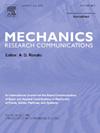非均匀柱线性屈曲分析的有限差分位移积分法
IF 2.3
4区 工程技术
Q3 MECHANICS
引用次数: 0
摘要
本文提出用有限差分位移积分法(FDDI)对受弯屈曲作用的柱进行数值分析。提出的屈曲分析方法是基于其他研究人员提出的方法,他们使用基于曲率的位移插值(CBDI)技术。CBDI技术在基于几何非线性力的框架元素领域内制定,采用截面弯曲曲率的拉格朗日插值。然而,当沿着单元长度放置许多正交截面时,这已经显示出数值不稳定性。因此,采用FDDI技术重新审视了所提出的屈曲分析方法,FDDI技术采用了截面相容条件的有限差分近似,产生了更鲁棒且计算等效的数值方法。数值实验验证了该方法的有效性,表明该方法有效地消除了数值困难,并可靠地收敛到精确解。本文章由计算机程序翻译,如有差异,请以英文原文为准。
Finite difference displacement integration for linear buckling analysis of non-uniform columns
This paper proposes the use of the Finite Difference Displacement Integration (FDDI) technique for the numerical analysis of columns subjected to flexural buckling. The proposed method for buckling analysis is based on the approach suggested by other researchers, who have used the Curvature Based Displacement Interpolation (CBDI) technique. The CBDI technique, formulated within the realm of geometrically nonlinear force-based frame elements, employs a Lagrange interpolation of the cross-section bending curvature. However, this has shown numerical instability when numerous quadrature cross-sections are placed along the element length. Consequently, the proposed buckling analysis method is revisited with the incorporation of the FDDI technique, which employs a finite difference approximation of the cross-section compatibility conditions, yielding a more robust, yet computationally equivalent numerical method. Numerical tests are conducted to evaluate the efficacy of the proposed method, demonstrating that the FDDI effectively eliminates numerical difficulties and reliably converges to the exact solution.
求助全文
通过发布文献求助,成功后即可免费获取论文全文。
去求助
来源期刊
CiteScore
4.10
自引率
4.20%
发文量
114
审稿时长
9 months
期刊介绍:
Mechanics Research Communications publishes, as rapidly as possible, peer-reviewed manuscripts of high standards but restricted length. It aims to provide:
• a fast means of communication
• an exchange of ideas among workers in mechanics
• an effective method of bringing new results quickly to the public
• an informal vehicle for the discussion
• of ideas that may still be in the formative stages
The field of Mechanics will be understood to encompass the behavior of continua, fluids, solids, particles and their mixtures. Submissions must contain a strong, novel contribution to the field of mechanics, and ideally should be focused on current issues in the field involving theoretical, experimental and/or applied research, preferably within the broad expertise encompassed by the Board of Associate Editors. Deviations from these areas should be discussed in advance with the Editor-in-Chief.

 求助内容:
求助内容: 应助结果提醒方式:
应助结果提醒方式:


